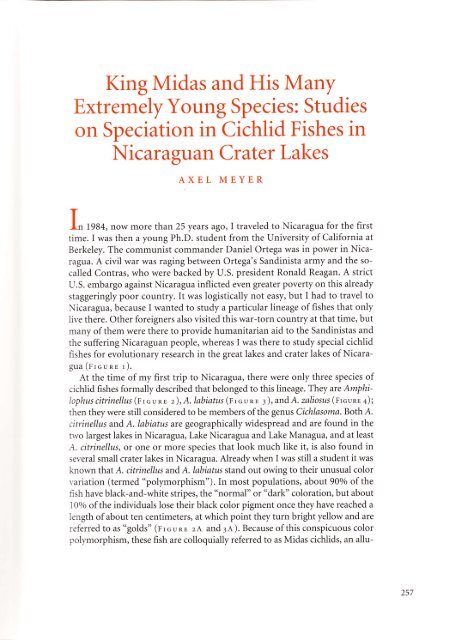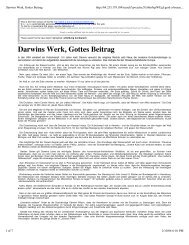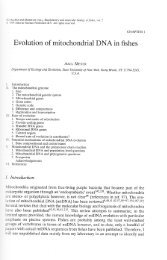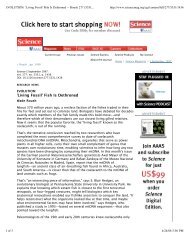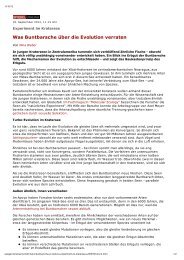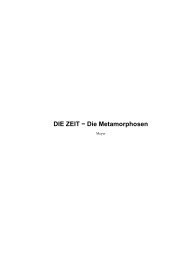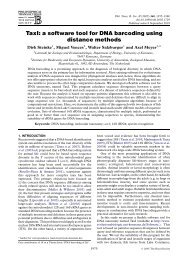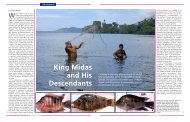King Midas and His Many Extremely Young Species: Studies ...
King Midas and His Many Extremely Young Species: Studies ...
King Midas and His Many Extremely Young Species: Studies ...
You also want an ePaper? Increase the reach of your titles
YUMPU automatically turns print PDFs into web optimized ePapers that Google loves.
<strong>King</strong> <strong>Midas</strong> <strong>and</strong> <strong>His</strong> <strong>Many</strong><br />
<strong>Extremely</strong> <strong>Young</strong> <strong>Species</strong>: <strong>Studies</strong><br />
on Speciation in Cichlid Fishes tn<br />
Nicaraguan Crater Lakes<br />
AXEL MEYER<br />
1984, now more than 25 years ago, I traveled to Nicaragua for the first<br />
time. I was then a young Ph.D. student from the University of California at<br />
Berkeley. The communist comm<strong>and</strong>er Daniel Ortega was in power in Nicaragta.<br />
A civil war was raging between Ortega's S<strong>and</strong>inista army <strong>and</strong> the socalled<br />
Contras, who were backed by U.S. president Ronald Reagan. A strict<br />
U.S. embargo against Nicaragua inflicted even greater poverty on this aheady<br />
staggeringly poor country. It was logistically not easy, but I had to travel to<br />
Nicaragua, because I wanted to study a particular lineage of fishes that only<br />
live there. Other foreigners also visited this war-torn country at that time, but<br />
many of them were there to provide humanitarian aid to the S<strong>and</strong>inistas <strong>and</strong><br />
the suffering Nicaraguan people, whereas I was there to study special cichlid<br />
fishes for evolutionary research in the great lakes <strong>and</strong> crater lakes of Nicaragua<br />
(Frcunr r).<br />
At the time of my first trip to Nicaragua, there were only three species of<br />
cichlid fishes formally described that belonged to this lineage. They are Amphilophuscitrinellus(Frcunr<br />
z),A.labiatus(Frcun.r t),<strong>and</strong>Ä. zaliosus(Frcunr4);<br />
then theywere still considered to be members of the genrs Cichlasoma.BothA.<br />
citrinellus <strong>and</strong> Ä. labiatus are geographically widespread <strong>and</strong> are found in the<br />
two largest lakes in Nicaragua, Lake Nicaragua <strong>and</strong> Lake Managua, <strong>and</strong> at least<br />
A. citrinellus, or one or more species that look much like it, is also found in<br />
several small crater lakes in Nicaragua. Already when I was still a student it was<br />
known that Ä. citrinellus <strong>and</strong> A. labiatus st<strong>and</strong> out owing to their unusual color<br />
variation (termed "polymorphism"). In most populations, about 90% of the<br />
fish have black-<strong>and</strong>-white stripes, the "normal" or "dark" coloration, but about<br />
l0% of the individuals lose their black color pigment once they have reached a<br />
length of about ten centimeters, at which point they turn bright yellow <strong>and</strong> are<br />
referred to as "golds" (Frcunn zA <strong>and</strong> 3A). Because ofthis conspicuous color<br />
polymorphism, these fish are colloquially referred to as <strong>Midas</strong> cichlids, an allu-<br />
257
258 M E y E R I <strong>King</strong> <strong>Midas</strong> <strong>and</strong> <strong>His</strong> <strong>Many</strong> <strong>Extremely</strong>young <strong>Species</strong><br />
L. As.<br />
Le6n<br />
L. Monte<br />
Galän<br />
L. Apoyeque<br />
L.Xiloä<br />
L. As. Managua<br />
L. Tiscapa<br />
L. Masaya<br />
L.Apoyo<br />
ru PACIFIC OCEAN<br />
l<br />
**' s 20km<br />
F r c u n s r Map of Nicaragua, showing the locations of the two great lakes <strong>and</strong> the crater lale..<br />
sion to <strong>King</strong> <strong>Midas</strong> in Greek mythology, who could turn everything he touc:::<br />
into gold. It is now known that this also occurs in some other species in str::.<br />
crater lakes in Nicaragua.<br />
Amphilophus labiatus (from the Latin word labia,lips) has its name beci*>:<br />
of its conspicuously enlarged lips (rrcunn 3A <strong>and</strong> 3B), which it uses. :: ..<br />
believed, as a kind of seal when it tries to suck prey species, such as crabs, ou: ,<br />
crevices between rocks. The third species that had been formally described<br />
",<br />
,<br />
separate species at the time of my first trip to Nicaragua is A. zaliostrs, callei ::-.<br />
"arrow cichlid" because of its narrow, elongated body. It had been scientific -"<br />
described less than 10 years before by -y Ph.D. advisor, George Barlorr-. .,-:<br />
one of his students (FrcunE +).It is only found in one of the crater lakes L-..<br />
Apoyo, Frcun E r ) in Nicaragua.<br />
George Barlow (1929-2007) <strong>and</strong> his students had been studying botl ._ .<br />
aggressive behavior <strong>and</strong> the mating behavior of Amphilophus citrinellu -. ::::<br />
Lake Nicaragua <strong>and</strong> from a craterlake called Lake Masaya (Frcunr r ) sin;< _..
<strong>King</strong> <strong>Midas</strong> <strong>and</strong> <strong>His</strong> Nlanv Estlenreh'\bung <strong>Species</strong><br />
F r c u n E z The "gold" <strong>and</strong> "norn-ral" rnorphs of A. citrinelhs from Lake Nicaragua.<br />
AB<br />
0-?Joi<br />
I t c u n E 3 The "gold" <strong>and</strong> "normal" rnorphs of A. Iabiatusftom Lake Nicaragua.<br />
:lid-1970s. He was interested in finding out exactly how <strong>and</strong> why "gold" <strong>and</strong><br />
"normal" black-<strong>and</strong>-white females prefer to breed with males of the same colorltion<br />
<strong>and</strong> how this color polymorphism affects aggressive interactions. That color<br />
:rattered in terms of sexual selection (that is, which mates are chosen for repro-<br />
Juction) could be seen in nature, where most of the breeding pairs (typically<br />
:lmost 95o/o or more) had the same body coloration. Also, when given a choice in<br />
:re laboratory, females prefer males of the same color as themselves over males of<br />
: diff-erent color. My Ph.D. advisor's interest was not so much in the evolutionary<br />
.t'rDSeQU€nc€s of this assortative mate choice but, rather, was focused on under-<br />
.:<strong>and</strong>ing the behavioral mechanisms that led to it. By contrast, my main interest<br />
'..'ls in gaining a better underst<strong>and</strong>ing of the processes by which new species arise.<br />
:'.'t-rlution by natural selection might lead to better ecological adaptations but it<br />
:::isht also result in the evolution of reproductive barriers <strong>and</strong>, hence, to the evo-<br />
. -:ion of new species. This could happen through assortative mating with indi-<br />
.;ttals that resemble each other ecologically or that resemble each other in color.<br />
259
260 \r E y E R I <strong>King</strong> <strong>Midas</strong> <strong>and</strong> <strong>His</strong> <strong>Many</strong> <strong>Extremely</strong><strong>Young</strong> <strong>Species</strong><br />
Fr cu nE 4 A.zaliosus,aspeciesendemicto LakeApoyo.<br />
* ,o go\so ro tlo t2o ls 1'o ls l'o 1?o ilo l$ 2t<br />
*'" ],'''"'<br />
.,, t I lwlu,i*h*tnhrillh,rhnhtu{mh$ttfirrturr\l,rti<br />
It was also noticed that, in lakes other than Lake Apoyo, there were individual<br />
fish that appeared to be of the same species that were somewhat morr<br />
elongated. Thus, not only was there variation in terms of the conspicuous color<br />
polymorphism, but there was also polymorphism in other characteristics that<br />
might have evolved repeatedly <strong>and</strong> independently in various lakes. This had to<br />
be explained. A number of hypotheses might explain this variation. One possibility<br />
was that what was initially thought to be one species was, in fact, ser'eral<br />
related species. This turned out to be the case. Now we know that there are<br />
about l2 (or perhaps even more) species of <strong>Midas</strong> cichlids.<br />
Because they live in crater lakes, this group of species of cichlid fishes also<br />
seemed to be an ideal group about which to ask some intriguing questions:<br />
under what geographic circumstances do mating preferences evolve? Is ecological<br />
speciation or speciation through sexual selection more common, or faster, in<br />
bringing about reproductive isolation <strong>and</strong> new species? As it turned out, some<br />
of the species of <strong>Midas</strong> cichlids in Nicaragua that live only in particular crater<br />
lakes might have arisen through this process of ecological speciation under<br />
sympatric conditions without geographic barriers (in sympatry) to gene florr.<br />
Traditionally, it had been thought that geographic separation is necessarl' for<br />
new species to arise, but we could show that new species can arise also within<br />
a very small body of water such as a crater lake, that does not have geographic<br />
barriers that nascent species could not cross to find mates. But the <strong>Midas</strong> cichlids<br />
of the crater lakes in Nicaragua present an opportunity to study not onh'<br />
sexual selection-in other words, the emergence of new species through selective<br />
breeding-but also to test theories of ecological species formation in this<br />
special geographic setting.<br />
The cichlid fishes from the great lakes of East Africa, where hundreds of<br />
endemic species of cichlids form so-called adaptive radiations, have also been
\\.HAT IS THE ROLE OF GEOGRAPHY IN THE ORIGIN OF SPECIES?<br />
investigated extensively with molecular-genetic tools b1'm1'laboratory for the<br />
past two decades. Cichlids became, alongside the Darwin's finches from the<br />
Galäpagos Isl<strong>and</strong>s <strong>and</strong> the Anolis lizards of the Caribbean, one of the best-studied<br />
model organisms for research on adaptation <strong>and</strong> speciation.<br />
WHAT IS THE ROLE OF GEOGRAPHY IN THE<br />
ORIGIN OF SPECIES?<br />
Under what geographic conditions can speciation happen? For Darwin, this<br />
question did not seem to matter all that much; at least, based on reading On<br />
tlrc Origin of <strong>Species</strong>, he did not specif in what geographic settings new species<br />
should or should not arise. This led later generations of evolutionary biologist<br />
to interpret Darwin's writings to suggest that species could arise without<br />
geographic barriers that separated previously interbreeding populations.<br />
This might occur if natural selection were to favor extremely different organisms-say,<br />
those that are the smallest <strong>and</strong> largest-while putting intermediate<br />
individuals at a disadvantage. In theory, such "disruptive selection" might<br />
Iead to the evolution of two distinctive species from a more variable ancestor.<br />
However, the idea that speciation could occur in situ by one species being<br />
separated into two within a locality (a process termed "sympatric speciation")<br />
had increasingly fallen into disfavor since the late 1930s <strong>and</strong> 1940s. This was<br />
because the architects of the so-called "modern synthesis," which combined<br />
the findings of various branches of evolutionary biology into a unified theory,<br />
tbcused on geographical conditions as the key precondition for speciation.<br />
They believed that geographic isolation was necessary so that genetic exchange<br />
rras not possible, allowing two populations to diverge from each other <strong>and</strong><br />
eventually to become different species. In such a geographic setting, natural<br />
selection played either no role or only a minor role, <strong>and</strong> speciation was seen as<br />
a mere by-product of geographic separation <strong>and</strong> not due to local adaptations<br />
to particular ecological conditions, as Darwin had thought speciation would<br />
rvork. Thus, natural selection came increasingly to be seen only as the key driving<br />
force on the path towards better adaptation within a population, but not as<br />
the mechanism for speciation.<br />
During his career, the famous evolutionary biologist Ernst Mayr (1904-<br />
1005) was, for many decades, one of the most influential proponents for the<br />
process of speciation by geographic restriction of gene flow, also called "allopatric<br />
speciation." (Allopatry means "living in different places.") According to<br />
this theory of geographic speciation, populations that are physically isolated for<br />
many generations accumulate so many genetic mutations quasi passively that,<br />
if the geographic boundary between those populations ceases to exist, the indiriduals<br />
in those populations are no longer able to interbreed. In other words,<br />
261
262 M E y E R I <strong>King</strong> <strong>Midas</strong> <strong>and</strong> <strong>His</strong> <strong>Many</strong> <strong>Extremely</strong> young <strong>Species</strong><br />
speciation occurs allopatrically, or alone owing to geographic isolation without<br />
the action ofnatural selection.<br />
Mayr was also responsible for defining the biological species concept, which<br />
stipulates that interbreeding defines species as reproductive units <strong>and</strong> separates<br />
them from other species. Mating choices-<strong>and</strong> thus, inversely, breeding barriers-are<br />
the key factor from the point of'view of the biological concept of<br />
species. only members of the same species should be able to breed with each<br />
other <strong>and</strong> produce fertile offspring. surely, that definition does not always hold,<br />
since hybridization between species can sometimes result in fertile individuals<br />
as well. Not least because of the influence of Ernst Mayr have evolutionanbiologists<br />
been focusing, therefore, on the geographic setting ofthe process of<br />
speciation <strong>and</strong> the origin of so-called isolating mechanisms that prevent individuals<br />
to mate across species boundaries. Traditionally, geographic isolation<br />
(allopatry) has been seen as all-important during the initial stages of species<br />
formation, <strong>and</strong> it was thought that, without such barriers (i.e., in sympatry), it<br />
is extremely difficult, or nearly impossible, for new species to arise.<br />
As a result of this kind of thinking, the origin of new species has been seen<br />
almost exclusively as a nonselective process-at least natural selection took on<br />
a subordinate role in this theory of speciation since differences between populations<br />
<strong>and</strong> isolating mechanisms are thought to accumulate passively over<br />
time <strong>and</strong> not due to selection forcing populations to become different. For<br />
decades, not least due to Ernst Mayr's influence, this model was perceived as<br />
the dominant mechanism bywhich new species come into being. On the other<br />
h<strong>and</strong>, sympatric speciation, the emergence of new species from a single population<br />
due to ecological selection without geographic barriers to gene florv,<br />
was seen as an impossible mechanism, or at least as a highly unlikely mechanism,<br />
for the emergence of new species, the reason being that genetic exchange<br />
between diverging populations would tend to homogenize them, preventing<br />
them from becoming distinctive species. This view is still pervasive today, <strong>and</strong>,<br />
possibly because of this, only very few empirical examples exist that show that<br />
species arose without geographic barriers to gene flow.<br />
THE ROLE OF NATURAL SELECTION DURING<br />
ECOLOGICAL SPECIATION<br />
However, this perception of adaptation <strong>and</strong> selection having only a minor<br />
role in speciation has changed during the last 10 to 15 years as more empirical<br />
examples have surfaced that support the idea that selection to different<br />
ecological niches can lead to the origin of species in a process that is norv<br />
referred to as "ecological speciation." It was recognized that Darwin, who<br />
had initially proposed that geography might not matter all that much, might
THE ROLE OF NATURAL SELECTION DURING ECOLOGICAL<br />
be correct after all. Darwin postulated that many, if not most, species might<br />
be arising by means of divergent natural selection that would favor the more<br />
extreme individuals, <strong>and</strong> that the average individual might be at a competitive<br />
disadvantage when compared with individuals at both extremes. How<br />
can such divergent selection lead to speciation? The idea is that ecological<br />
speciation, as it's now called, can lead to reproductive isolation between<br />
populations, or between portions of individual populations, through adaptations<br />
to different ecological niches or to different environments. If such<br />
individuals that are adapted to the ecological extremes mated only among<br />
themselves, then two new species might arise through this process of ecological<br />
adaptation <strong>and</strong> through mating assortatively within one's type.<br />
As I will detail at greater length below, the <strong>Midas</strong> cichlids provide compelling<br />
empirical examples that ecological sympatric speciation has led to the<br />
origin of new species in Nicaraguan crater lakes. We found that sympatric<br />
speciation can occur both through ecological speciation by natural selection<br />
acting through adaptations to different ecological niches <strong>and</strong> by sexual selection.<br />
The latter mechanism might work in sympatry, leading to the origin<br />
of new species, if animals mated only with animals that looked like them<br />
<strong>and</strong> not with other animals that, for example, had a different color, but still<br />
belonged to the same species.<br />
THE SECOND IAW OF CICHLIDS<br />
Äll cichlids possess a functional second jaw, known as the pharyngeal jaw,<br />
rvhich enables them, with the teeth on these jaws, to process sources of food<br />
that remain inaccessible to other fish. These jaws developed evolutionarily from<br />
the fifth bony gill arc, which still holds gills for breathing in many species that<br />
diverged early in fish evolution. The evolutionary innovation of this "second<br />
iarv" probably contributed toward making the family Cichlidae, containing a<br />
total of probably more than 3,000 species, such an evolutionary success. It is<br />
thought that, by possessing the "normal" jaw with particular types of teeth as<br />
rvell as their functionally second jaw, cichlid fishes can be particularly efficient<br />
in feeding, as well as using ecological resources (such as hard snails that only<br />
ther. are able to crack) that are not available to other families of fishes. Theretore,<br />
the evolution of such jaws, coupled with other factors (such as their conspicuous<br />
coloration, which might play a role in sexual selection <strong>and</strong> speciation<br />
through mate choice) contributed to the evolutionary success of cichlid fishes.<br />
During my Ph.D. work, I noticed that the individuals of the presumed single<br />
species A. citrinellu.s not only differed in color, but also in some specific morphological<br />
aspects-in particular, in such ecologically highly relevant structures<br />
as their so-called "pharyngeal jaws" (Frcu*. s ). There was also pronounced
264 M E y E R I Ki"g <strong>Midas</strong> <strong>and</strong> <strong>His</strong> <strong>Many</strong> <strong>Extremely</strong> young <strong>Species</strong><br />
F r c u n E 5 An x-ray image of an Amphilophus citrinellus from Lake Nicaragua with pronounced<br />
(molariform) pharymgeal jaws. Note that this fish has cracked <strong>and</strong> ingested many snail shells, as can<br />
be seen in high contrast in its intestine.<br />
variation in body shape within <strong>and</strong> between the populations of <strong>Midas</strong> cichlids<br />
of any single lake, with particularly marked differences in the shape of this<br />
"second" jaw, but also in other characteristics. some <strong>Midas</strong> cichlids aie able to<br />
grow very strong "molariform" pharyngeal jaws (trcunr e ), which carry verv<br />
strong "molar teeth" that enable them to break hard snail shells, while others<br />
have "papilliform" pharyngeal jaws with small, sharp teeth with which thel'<br />
can macerate efficiently such soft foods as insect larvae. However, the <strong>Midas</strong><br />
cichlids with papilliform jaws are unable to break snails' shells. Thus, there<br />
were clear ecological differences that were caused by these differences in the<br />
teeth of the two populations of <strong>Midas</strong> cichlids. It seemed feasible to propose<br />
that this variety of forms associated with feeding may be one of the decisive<br />
factors contributing to the emergence of new species, possibly through ecological<br />
speciation.<br />
THE GEOGRAPHIC SETTING AND THE<br />
COLONTZATION OF THE NICARAGUAN CRATER LAKES<br />
The western part of Nicaragua is underlain by one of the world's most volcanically<br />
active areas. Known as the Central American volcanic Arc, it is part oi<br />
the "Pacific Rim of Fire." After a volcano cools, the tlpically cone-shaped crater<br />
fills with groundwater <strong>and</strong> rainwater <strong>and</strong> becomes a crater lake. The crater
THE GEOGRÄPHIC SETTI\G<br />
F r c u n r 6 Specimens of "papilliform" <strong>and</strong> "molariform" lower pharyngeal jaws. These kinds of<br />
morphological differences allow the fishes to exploit different trophic resolrrces diffelentially in their<br />
environment. Fishes with strongly enlarged teeth are able to crack hard snails, a food source that is<br />
not available to the individuals with the rnuch weaker teeth (papilliform morph), but the latter are<br />
mole efficient in feeding on softer qpes of prey.<br />
lakes in Nicaragua are characteristically oligotrophic-that is, they contain only<br />
t!n'nutrients in the water for primary production by algae, <strong>and</strong> they do not<br />
have any inflows or outflows. Typically, after some time, such crater lakes are<br />
colonized by aquatic organisms, including cichlid fishes. At least eight NicaraqLran<br />
crater lakes have been successfully colonizedby <strong>Midas</strong> cichlids (FrcunE<br />
., T.r.sr-E r). It is not known, for each case, how or when those colonizations<br />
t'rccurred, but it is generally thought to have been through such natural phelromena<br />
as hurricanes, "fish rains," or by fish having been dropped inadver-<br />
:ently by fish-eating birds, such as cormorants, bald eagles, or ospreys, although<br />
some lakes may have been stocked with fish by humans. ("Fish rains" are rare<br />
neteorological phenomena caused by waterspouts, which have been reported<br />
:o be able to pick up large quantities of water from bodies of water, including<br />
:he resident fish, <strong>and</strong> to drop this water elsewhere.) Initially, the crater lakes<br />
:.roi'ided empty spaces that, once the lakes had been colonized, were quickly<br />
:rlled by newly arriving species. Because of their geographic isolation <strong>and</strong><br />
-uo\vn geological history, crater lakes are excellent natural systems for studying<br />
:he evolution of species both in allopatry <strong>and</strong> in sympatry.<br />
The two largest <strong>and</strong> oldest lakes in Central America are the great lakes Mana-<br />
.'.ra <strong>and</strong> Nicaragua. These date to the early Pleistocene Epoch, <strong>and</strong> together<br />
.:'rev cover approximately 9,000 km2. Lake Managua lies at an elevation 7 or 8 m<br />
,::gher than the elevation of Lake Nicaragua (F r c u n E r ). Connectivity between<br />
:rise t\vo Iakes has varied, depending on the fluctuating level of the water in<br />
.:e lakes: River Tipitapa rarely but periodically connects Lake Managua to Lake<br />
265
266<br />
q<br />
0)<br />
& (ü<br />
(!<br />
bD<br />
d<br />
tr<br />
tg<br />
(J<br />
2<br />
C)<br />
u XC)<br />
g<br />
8<br />
q)<br />
a<br />
a.)<br />
A<br />
o<br />
(,)<br />
q<br />
rd<br />
a o<br />
d<br />
lr<br />
(J<br />
bD<br />
€<br />
d<br />
(ü<br />
I<br />
öo<br />
o<br />
ri<br />
(.)<br />
-(!<br />
H<br />
iJLt<br />
o()<br />
(dQ.<br />
'46<br />
ä<br />
0)^<br />
od<br />
-(ütr<br />
!v<br />
o.<br />
z<br />
!<br />
!)<br />
z<br />
F]<br />
o<br />
}R<br />
fr<br />
is<br />
:F<br />
rüN<br />
;)<br />
!.\-\qqq<br />
ER:EEE<br />
S .r qi :s S S<br />
s ss i Li i i<br />
'x<br />
v 3.n 'r 'F<br />
s\ s q !<br />
rn<br />
c.l<br />
o$co<br />
N<br />
aoono<br />
O\cOnciO 0$\o<br />
N<br />
€F\6<br />
OO€<br />
t t SeS ts::<br />
qq<br />
s : ^ .: s .-<br />
S F FF.S FF:S<br />
'ü ü GS'R '-s 3t<br />
O\mrn<br />
NN<br />
ci c; r;<br />
! .'zQ * F ";<br />
O<br />
\o<br />
Ho*a<br />
E<br />
Ept E*E: i e;f H f* t=<br />
FfE rF:F EE .=:E EEä; li<br />
9:E 'giR: :- Er+<br />
.-EE äöo.= . -ä.on *.9S € :E:5 :€ä;<br />
=- Z;<br />
f"l€ gEEi E€ !+; g r?t= s j2<br />
$äf Eg:* Eü EI: € Er-Ej .g ir;<br />
äPg iaEf ;=:E: ä t-EH+ g 2=:<br />
_äg€ €€ä g" .*"i Eoo 's äE J:r.; : y2<br />
=QEU>3ET 9E IT: E EF;;ä ä E=<br />
EEE*EÄ€ä gi ;rE E EE;5E i Ez<br />
süEEsäEr €ä Ä:A : ;$!-tE ä t:<br />
=E;rc IEE.eci >-tr P^^i c .2E t"9'i ;. i!<br />
!ü€+Eü;gs!:ä .cI"ä i ää*ÄE j !7<br />
ääir ü ääig €€ FäE € EE *tE 3 i!<br />
'äi+E;tseE:l<br />
=s#sE<br />
$Er:ä ä ii<br />
*:rüE€xfE:ssscgiE äE€äl € E=<br />
ääEE $I€ :E gix Eääi ä, ii Bää .E =yi<br />
iiii g$äE$I äEE?i ä äE EiiEä E<br />
$<br />
=z:<br />
9?'oG qo<br />
-<br />
.6qE=<br />
4u --.: 2<br />
O.d<br />
Jz s! d<br />
Y =G-<br />
;P' ^ H I s v -<br />
+<br />
ia9do't<br />
EX X 2 e A<br />
- H'^<br />
Eä E- 9, 2 ä E g<br />
u< ! EHTÜ:<br />
<<br />
Z F X 9 23 Z:<br />
ac
{D DIVERSITY OF THE \IID.{S CICHLID LINEAGE<br />
Nicaragua when water levels are unusually high. The great lakes are exceptionally<br />
shallow (mean depth around 8.6 m for Lake Managua <strong>and</strong> I2.4 m for Lake<br />
Nicaragua) <strong>and</strong> have gently sloping basins, allowing wind to stir the sediments.<br />
This <strong>and</strong> a high prevalence of phytoplankton make the water of the great lakes<br />
very turbid. Thus, this habitat is very different from the clear, deep waters of the<br />
crater lakes.<br />
THE TAXONOMY AND DIVERSITY OF THE MIDAS<br />
CICHLID LINEAGE<br />
The taxonomy of these cichlids from Nicaragua had been difficult since the start<br />
of their biological investigation. They were first studied at the beginning of the<br />
nventieth century by the ichthyologist Seth Eugene Meek of the Field Museum<br />
in Chicago. He lamented that he could not decide whether he was dealing with<br />
only two species or with up to 6 different species because the fish from different<br />
lakes looked so different, but they also had commonalities across lakes. For<br />
example, cichlid fish with enlarged lips are found not only in the two big lakes<br />
but also in some of the small crater lakes. But it was not clear to Meek whether<br />
he should consider those fish to be the same or different species. This conundrum<br />
is still not yet solved completely. Today, however, it is clear, based on the<br />
comparative genetic data that we have collected in all of these populations, that<br />
the two great lakes are the ancient source of the population of <strong>Midas</strong> cichlids.<br />
From these, the much younger crater-lake populations were seeded, <strong>and</strong> several<br />
nerv species arose, each ofwhich lives in only a single crater lake in Nicaragua.<br />
We could show, based on several lines of genetic evidence, that <strong>Midas</strong> cichlids<br />
from single crater lakes are genetically more similar to each other than they<br />
are to the <strong>Midas</strong> cichlids in any other lake. At present, there are nine species<br />
described in the <strong>Midas</strong> species complex (Te n r E r ). Based on rapidly evolving<br />
genetic markers (such as so-called microsatellite DNA) of the qpe that are also<br />
used in paternity analyses <strong>and</strong> in the analysis of DNA from crime scenes, one<br />
can now distinguish many of these species genetically, although not all of the<br />
species <strong>and</strong> crater lakes have been investigated in sufficient detail so far. It is<br />
likely that, in the near future, still more species from the crater lakes will be<br />
described taxonomically <strong>and</strong> that the validity of the original species A. " citrinel-<br />
/rr-." will need to be revisited-surely it is composed of more than one species.<br />
Therefore, it is best to refer conservatively to <strong>Midas</strong> cichlids found in multiple<br />
crater lakes as A. cf. citrinellus.<br />
Based on a large amount of genetic work, we ended up concluding that each<br />
of the crater lakes in Nicaragua, even those that are only 1,000 to 23,000 years<br />
old (renrr r), contains its own set of endemic species of <strong>Midas</strong> cichlids. It<br />
is clear from our genetic data that many, if not all, of these species must have<br />
267
268 M E y E R I<br />
<strong>King</strong> <strong>Midas</strong> <strong>and</strong> <strong>His</strong> <strong>Many</strong> <strong>Extremely</strong>young <strong>Species</strong><br />
arisen through speciation in sympatric geographic settings, since the crater<br />
lakes in Nicaragua do not have any geographic barriers that would prevent fish<br />
within one crater lake from interbreeding.<br />
EVOLUTION REPEATS ITSELF IN THIS HIGHLY<br />
VARIABLE LINEAGE OF CICHTID FISHES IN BODY<br />
FORM, LIPS, SECOND IAWS, AND COLORATION<br />
The <strong>Midas</strong> cichlids are highly variable for such ecologically relevant attributes<br />
as body shape, pha4mgeal- jaw apparatus, <strong>and</strong> hypertrophied lips. Moreover, it<br />
is interesting that evolution apparently repeated itself, since some tlpes evolved<br />
more than once. This applies to the so-called "limnetic" species that tend to live<br />
more in the open water <strong>and</strong> to have slender, elongated bodies, to deeper-bodied<br />
"benthic" species, <strong>and</strong> also to species with hypertrophied big lips.<br />
such limnetic species as A. sagittae, which is endemic to Lake Xiloä, <strong>and</strong> A.<br />
zaliosus,which is endemic to Lake Apoyo, are elongated in their body form, <strong>and</strong><br />
have papilliform pharyngeal jaws, while such benthic species as A. astorquü, A.<br />
chancho, A. flaveolus in Lake Apoyo, <strong>and</strong> A. amarillo <strong>and</strong> A. xiloaensis in Lake<br />
Xiloä (r a n r n r ) are more high-bodied-more closely associated with the benthos-<strong>and</strong><br />
tend to have molariform pharyngeal jaws. Amphilophuslabiatushas<br />
a slightly more elongated body, a more pointed snout, more lateral compression,<br />
<strong>and</strong>, most obviously, dramatically hypertrophied lips when compared<br />
withÄ. citrinellus from the two large lakes (FrcunEs 2 <strong>and</strong>:).Interestingly,a<br />
similarly thick-lipped morph is found at moderate frequencies (approximately<br />
260/o) in Lake Apoyeque, where it occupies an ecological niche that is distinct<br />
from that of the more abundant thin-lipped morph; big-lipped fish are also<br />
found, albeit much more rarely, in crater lakes Masaya <strong>and</strong> Xiloä. Those are<br />
potentially novel species that are still awaiting taxonomic description.<br />
Other species in the <strong>Midas</strong> cichlid species complex than the previously mentioned<br />
A. cf . citrinellus <strong>and</strong> A. Iabiatus (Frcunrs z <strong>and</strong> 3) from the large lakes are<br />
polychromatic. The more common morph is the grayish "normal" (or "dark")<br />
morph with spotted, striped, <strong>and</strong> barred patterns, while the "gold" morph is<br />
uniformly orange, yellow, or even white. All of these fish begin life "dark" <strong>and</strong><br />
some of them later lose their melanophores (the skin cells that cause the dark<br />
color) <strong>and</strong> become "gold" (or, more rarely, even completely white, lacking the<br />
cells that cause both dark <strong>and</strong> yellow color) permanently. Gold morphs are<br />
found in moderate to low frequencies (e.g.,120o/o in A. xiloaensls <strong>and</strong>
SEXUAL SELECTION DUE TO -\SSORTI\-E \TÄTING<br />
SEXUAL SELECTION DUE TO ASSORTIVE MATING<br />
CAN BRING ABOUT NEW SPECIES IN SYMPATRY<br />
Strong assortative mating based on color has been shown in the field <strong>and</strong> laboratory.<br />
We have shown, in <strong>Midas</strong> cichlids from Lake Xiloä, that such assortative<br />
mating may be resulting in speciation in sympatry, since gold <strong>and</strong> dark morphs<br />
of the Lake Xiloä are endemic species A. xiloaensis are already notably genetically<br />
differentiated, due to strong assortative mating based on coloration. Pairs<br />
in which both the female <strong>and</strong> the male are of the same color are found much<br />
more commonly than would be expected by chance. Therefore, we found that<br />
trsh of the same color more often chose to mate with each other. Because they<br />
breed more often with their own kind, populations of the two color morphs<br />
do not often exchange genes <strong>and</strong> therefore their genetic differences tend to<br />
accumulate. It is interesting that, in contrast with this finding, we discovered<br />
that gold <strong>and</strong> dark morphs of A. cf . citrinellus <strong>and</strong> A. labiatus from the great<br />
lakes show little or no genetic differentiation, although these are surely older<br />
species. We don't know whether or not these species of the large lakes mate so<br />
strongly according to color. Unfortunately, because the water in large lakes is<br />
very cloudy, behavioral observations of the breeding behavior of <strong>Midas</strong> cichlids<br />
are not possible there.<br />
Disruptive selection based on color polymorphism might contribute to the<br />
diversification of the cichlids of the Great Lakes of Africa as well, since many<br />
species from there are also known to be polymorphic with respect to color<br />
<strong>and</strong> because females often strongly prefer to mate with one type of male over<br />
another. Previously, this mechanism had not been convincingly demonstrated<br />
to act under sympatric conditions for species that are polymorphic for coloration.<br />
Assortative mating, changes in selection, <strong>and</strong> selection based on the<br />
tiequency of one type or another by predation or intrasexual competition are<br />
believed to be able to contribute to the persistence of genetically different color<br />
morphs within one population.<br />
However, sexual selection is also likely to play a role in the sympatric origin<br />
of at least some of the other species or species-pairs that differ in their coloration.<br />
This can happen through assortative mating. Breeding of each species<br />
often occurs in close proximity in these lakes; sometimes two different species<br />
breed even within a meter or two of each other. That they do not interbreed<br />
argues for strong selection for fast evolution of mechanisms for prezygotic<br />
reproductive isolation. Sympatric speciation "in the making" by sexual selection<br />
based on color (either gold or dark) was discovered by us just recently<br />
lor A. xiloaensis from crater lake Xiloä. This was inferred from observational<br />
t-ield studies <strong>and</strong> also from the analysis of genetic data that show that they can<br />
already be distinguished from each other genetically. Theoretical verbal <strong>and</strong><br />
269
270 M E y E R I Ki"g <strong>Midas</strong> <strong>and</strong> <strong>His</strong> <strong>Many</strong> <strong>Extremely</strong> <strong>Young</strong> Specres<br />
mathematical models had before suggested that such speciation is possible,<br />
but evidence from nature had been wanting.<br />
PROCESS OF SYMPATRIC SPECIATION IN<br />
NICARAGUAN CRATER-LAKE CICHLIDS<br />
<strong>Many</strong> theoretical insights about how new species can evolve without geographical<br />
barriers have been put forward. However, empirical examples for speciation<br />
in the face of potentially continuous homogenizing gene flow owing to a lack of<br />
geographic barriers remain scant. Theory suggests that speciation could occur if<br />
a characteristic of a species is simultaneously affected by the same genes that are<br />
responsible both for mating with one's kind <strong>and</strong> for natural selection by ecological<br />
specialization. It is thought that isolated habitats, such as isl<strong>and</strong>s <strong>and</strong> crater<br />
lakes, are the most promising places to identify diversification in sympatry<br />
because, if new species exist there <strong>and</strong> only there, they probably arose in that<br />
small, geographically isolated locality. Therefore, some of the most compelling<br />
cases of speciation without geographical barriers to gene flow come from cichlid<br />
fishes from crater lakes, where it is believed that speciation is driven by disruptive<br />
natural selection for ecological traits.<br />
Because crater lakes are small, geographically isolated settings, they are ideally<br />
suited as biological systems for the study of sympatric speciation. For two<br />
different crater lakes, we believe that we have found evidence that speciation<br />
can occur in syrnpatry, but through two different mechanisms-once through<br />
ecological speciation (in the case of A. zaliosus from Lake Apoyo) <strong>and</strong> through<br />
assortative mating based on a color polymorphism (in the case of A. xiloaensis<br />
from Lake Xiloä).<br />
How exactly could this have happened? In all cases where multiple <strong>Midas</strong><br />
cichlid species have so far been recognized within a crater lake (T e r r r r ), they<br />
have different ecologies <strong>and</strong> morphologies, which is strongly suggestive of the<br />
effect of disruptive natural selection to exploit different intralacustrine niches.<br />
Cichlid populations that inhabit a single crater lake find different sources of<br />
food at different locations within a lake, as we could show based on the analysis<br />
of their stomach contents.<br />
These observations, combined with molecular <strong>and</strong> comparative morphometric<br />
analyses, led us to suggest that the mechanism of speciation in the case<br />
of A. zaliosus in Lake Apoyo is through ecological speciation in sympatry' The<br />
new species would be adapted to feed on different diets in different parts of the<br />
lake <strong>and</strong> might also there find its mates. The Arrow cichlid is only found in this<br />
crater lake, which is completely isolated from other lakes <strong>and</strong> rivers, just as are<br />
all of the other crater lakes in Nicaragua. We have studied its origin in greater<br />
detail in recent years using genetic, morphological, <strong>and</strong> ecological methods. It
CESS OF SYNIPÄTRIC SPECIÄTION<br />
turned out that the Arrow cichlid not only differs from the original species of<br />
\Iidas cichlid that colonized Lake Apoyo in terms of appearance <strong>and</strong> genetics,<br />
but that it also probably originated in this lake less than 10,000 years ago. It<br />
only breeds with other members of its own species, which has also been demonstrated<br />
by preferential partner selection in the laboratory, <strong>and</strong> it relies on<br />
other sources of food <strong>and</strong> more often lives at greater depths <strong>and</strong> farther from<br />
the shore then the originally colonizing species.<br />
This type of speciation probably best explains the evolution of several more<br />
species of morphologically <strong>and</strong> therefore ecologically different endemic spe-<br />
cies of <strong>Midas</strong> cichlids in the Nicaraguan crater lakes. Even when speciation is<br />
still incomplete, there can be intralacustrine ecological differentiation, as we<br />
recently showed for the extremely young (T e n r r r ) Lake Apoyeque (it is less<br />
then 1,800 years old), where we found that about 20o/o of the individuals have<br />
pronounced lips, as do individuals ofÄ. labiatus from the large lakes. But, even<br />
based on a large set of quickly evolving microsatellite markers, we could not<br />
distinguish the lipped fish from the unlipped fish within Lake Apoyeque statistically.<br />
Hence, ecological differentiation can occur much faster than even rapidlr'evolving<br />
genetic markers can track; thus, the absence of genetic differentiation<br />
between ecotlpes does not refute ecological speciation. Alternatively, we<br />
might be dealing with only a polymorphism in a population without assortative<br />
mating <strong>and</strong>, hence, not with genetic differentiation. Underwater observations<br />
rrould be necessary to show whether individuals with big lips prefer to mate<br />
rrith each other.<br />
THE CRATER LAKES OF NICARAGUA PROVIDE<br />
NATURAT REPLICATED EXPERIMENTS IN<br />
ULTRAFAST SPECIATION<br />
Comparative morphological analysis of all the species in the <strong>Midas</strong> cichlid spe-<br />
;ies complex across six crater lakes <strong>and</strong> both great lakes in Nicaragua showed<br />
that the <strong>Midas</strong> cichlid from each lake has its own characteristic body shape<br />
ihat distinguishes it from other <strong>Midas</strong> cichlids from other lakes. Also, the body<br />
.hapes of the <strong>Midas</strong> cichlids from the great lakes are distinct from those inhabi:ing<br />
the crater lakes. such a pronounced variation in body shape between the<br />
\lidas cichlids in the great lakes <strong>and</strong> those in the crater lakes is not unexpected<br />
recause the clear, deep waters ofcrater lakes are quite different from the shal-<br />
.orr-<strong>and</strong> turbid environment in the great lakes of Nicaragua. Each lake is difier-<br />
:nt trom all other lakes, whether they be crater lakes or great lakes.<br />
The populations of <strong>Midas</strong> cichlids from the crater lakes Asososca Managua<br />
:rd Apoyo were found to be the most divergent in body shape. However, the<br />
:rapes of some individuals from some crater lakes overlap (particularly in indi-<br />
271
272 M E y E R I <strong>King</strong> <strong>Midas</strong> <strong>and</strong> <strong>His</strong> <strong>Many</strong> <strong>Extremely</strong> young <strong>Species</strong><br />
viduals from lakes Asososca Le6n <strong>and</strong> Apoyeque, <strong>and</strong> Xiloä <strong>and</strong> Apoyo), <strong>and</strong><br />
the shapes of some individuals from the great lakes was also found to o\/erlap.<br />
This observation suggests that similar body shapes independently arose in<br />
species of <strong>Midas</strong> cichlids that inhabit those pairs of lakes. Nonetheless, some<br />
crater lakes arevery young, especially Asososca Managua (which only formed<br />
roughly 1,200 years ago) <strong>and</strong> Apoyeque (which formed roughly 1,800 years<br />
ago (Tenr. r). Therefore, the change in body shape that comes with colonization<br />
of a new crater lake must occur exceedingly fast. we estimate that some<br />
of these morphological changes <strong>and</strong> speciation events took place within onlv<br />
a few hundred or a few thous<strong>and</strong> generations. This, we think, may turn out<br />
not to be unusual, but rather we assume that future research will find other<br />
examples of extremely fast evolution. This may turn out to be more the rule<br />
<strong>and</strong> not an exception.<br />
The greatest changes in the evolution of body shape across the entire <strong>Midas</strong><br />
cichlid species complex occured in the shape of the head <strong>and</strong> mouth, the size<br />
of the head, the depth <strong>and</strong> length of the body, <strong>and</strong> the width of the tail region.<br />
These are also body-shape characteristics that have been found, in other cichlid<br />
studies, to relate to trophic niche <strong>and</strong> ecological selection as they relate to horv<br />
<strong>and</strong> where the fish forage. Thus, these findings, interpreted in light of previous<br />
research on ecomorphology in the species complex, suggest a strong role<br />
for ecological selection <strong>and</strong> adaptation in the diversification of body shapes in<br />
<strong>Midas</strong> cichlids.<br />
Some morphologies are repeated across lakes (e.g., lipped fish that most<br />
likely arose several times independently in Lake Nicaragua <strong>and</strong> the crater lakes<br />
Apoyeqe, Masaya, <strong>and</strong> Xiloä). The limnetic, open-water species A. zaliostts<br />
from Lake Apoyo <strong>and</strong> its ecological equivalent species, A. sagittaein Lake Xiloä,<br />
arose through ecological speciation under sympatric conditions more than<br />
once. These large-scale morphological changes are expected to arise, <strong>and</strong> they<br />
will permit the initial macrohabitat shift, or colonization of a new environment<br />
within the crater lake, <strong>and</strong> they will be the first evolutionary events to occur<br />
during the formation of an adaptive radiation. Founding events, in that only a<br />
portion of the genetic variation of the source population is transferred with the<br />
ancestral population of a small crater lake, may also be important factors contributing<br />
to speciation, since only few individuals are likely to colonize a new<br />
crater lake. This, too, will influence or limit future directions of morphological<br />
innovation or speciation in particular species assemblages. Local adaptations<br />
<strong>and</strong> ecological character displacement are two additional factors that are very<br />
likely to interact strongly in crater lakes that contain multiple ecological species<br />
(such as Lake Apoyo, Lake Xiloä, <strong>and</strong> possibly also Lake Apoyeque).<br />
The crater lakes of Nicaragua are a natural experiment in the sense that every<br />
one of the lakes (at least as far as we are able to determine) was independently
ÄRE THERE OTHER SPECIES THAT ARE YET TO BE DESCRIBED?<br />
seeded from one or more of the large lakes. This raises the question of whether<br />
er.olution repeats itself. Repeated or parallel evolution-similar solutions to the<br />
same ecological challenge-would imply that there is predictability <strong>and</strong>, theretbre,<br />
that there are rules of diversification to be discovered. Moreover, those<br />
rules would then presumably apply not only to the evolution of the <strong>Midas</strong> cichlid<br />
adaptive radiation across time <strong>and</strong> space, but would be expected to apply<br />
more generally.<br />
An analysis of body shape with ecological niche <strong>and</strong> inferred adaptation<br />
across lakes would be important in order to clarifr whether similar or different<br />
selection regimes act in each of these crater lakes. But the exact role that ecological<br />
selection <strong>and</strong> adaptation played in driving the evolution of morphological<br />
variation <strong>and</strong> speciation in the <strong>Midas</strong> cichlid species complex still needs to be<br />
examined in more detail.<br />
ARE THERE OTHER SPECIES THAT ARE YET<br />
TO BE DESCRIBED?<br />
Comparative morphological analysis showed that the populations of <strong>Midas</strong><br />
cichlids in the large lakes, as well as those in each of the crater lakes, look<br />
slightly but distinguishably different. Therefore, based on morphology alone,<br />
this would argue that all populations of <strong>Midas</strong> cichlids are different from each<br />
other <strong>and</strong> should be considered to be different species.<br />
Particularly for crater lakes with one described species, it is quite possible<br />
that there are still new species to be described. For example, the crater lakes in<br />
rvhich A. cf. citrinellus-Apoyeque, Asososca Le6n, Asososca Managua, <strong>and</strong><br />
\Iasaya-is supposed to live may actually contain several novel species that<br />
are, as of yet, undiscovered or in need of forrnal taxonomic description. For<br />
erample, the morphs with hlpertrophied lips that occur in lakes Apoyeque <strong>and</strong><br />
\Iasaya might need to be considered to be new species. In Asososca Managua,<br />
rve collected a relatively elongated A. cf. citrinellus at low frequencies, <strong>and</strong> future<br />
research may identify it as an incipient limnetic ecotFpe or even a new species.<br />
-\sososca Managua has a large water volume, the smallest littoral zone of all<br />
crater lakes, <strong>and</strong> clear water; thus, it is feasible that rapid speciation to exploit<br />
the open-water limnetic niche might have occurred there. Lake Masaya is maximally<br />
6000 years old. Given the examples of other crater lakes in the region of<br />
similar age, Lake Masaya might be expected to harbor multiple species, though<br />
thev have not yet been described. However, the lake has experienced frequent<br />
lolcanic activity even as recently as 1,800 years ago. It is unknown to what<br />
e\tent such eruptions might affect a crater lake's fauna, but it is conceivable<br />
that they could have eliminated or decimated the entire fish population repeatedlv.<br />
Additionally, historical documents indicate that there were no large fish,<br />
273
274 M E y E R I<br />
<strong>King</strong> <strong>Midas</strong> <strong>and</strong> <strong>His</strong> <strong>Many</strong> <strong>Extremely</strong> <strong>Young</strong> <strong>Species</strong><br />
such as <strong>Midas</strong> cichlids, in Masaya 450 years ago, which raises the interesting<br />
possibility that the <strong>Midas</strong> cichlid population in Lake Masaya is only a few centuries<br />
old. Either of these scenarios could explain both the low genetic diversin'<br />
we have recorded <strong>and</strong> the apparent paucity of morphological variation of Lake<br />
Masaya's <strong>Midas</strong> cichlid fauna.<br />
MORE WORK REMAINS TO BE DONE<br />
The underst<strong>and</strong>ing of the processes that might lead to the origin of new species<br />
has changed in the past decade, partly through the study of cichlid fishes<br />
from the crater lakes in Nicaragua. The geographical aspects as well as the roles<br />
played by natural <strong>and</strong> sexual selection in speciation have been revised recently.<br />
Under certain circumstances, ecological specialization can indeed result in new<br />
species evolving very quickly <strong>and</strong> within a single population. If selection is sufficiently<br />
strong, this can happen even without geographical barriers to prevent<br />
the movement of genes. This type of selection works, just as Darwin envisioned<br />
it, against average individuals <strong>and</strong> in favor of extreme specialists-in the case of<br />
the <strong>Midas</strong> cichlid, for example, those individuals with particularly molariform<br />
or papilliform jaws, or those with especially long bodies, which are able to move<br />
more efficiently in open water, or others whose body shape enables them to<br />
maneuver particularly well close to the shore.<br />
The <strong>Midas</strong> cichlid species complex has provided us one of the few examples<br />
that are known to date of the emergence of new species without geographical<br />
barriers-of sympatric speciation in nature. According to these findings, at<br />
least one new species (A. zaliosus) has come into being through ecological speciation<br />
within a few thous<strong>and</strong> generations in crater Lake Apoyo <strong>and</strong> another<br />
(A. xiloaensis) equally fast through assortative mating <strong>and</strong> sexual selection in<br />
crater Lake Xiloä. We don't know yet for sure which type of speciation is faster<br />
or more common.<br />
In order to underst<strong>and</strong> how new species emerge at a genetic level, we are<br />
now seeking to identifu the genes that control the morphological <strong>and</strong> ecological<br />
differences between these young species. This also entails identifying how<br />
many genes are involved in shaping particular aspects of their morphology <strong>and</strong><br />
which types of mutation caused the phenotypic differences between those species.<br />
It will be particularly interesting to work on species-pairs that evolved their<br />
similar morphologies independently to ask whether evolution repeats itself also<br />
at the molecular level or whether evolution has found independent genetic <strong>and</strong><br />
developmental ways to respond to similar ecological challenges in different crater<br />
lakes.<br />
Methodological developments, such as new techniques <strong>and</strong> machines for<br />
sequencing entire genomes quickly, now allow for the large-scale projects that
MORE WORK REMAINS TO BE DONE<br />
are necessary to accomplish these tasks. We would then hope to learn which<br />
genes-<strong>and</strong> how many mutations, <strong>and</strong> of which type-bring about the differences<br />
between species. One could then hope to learn whether evolution repeats<br />
itself also at the level of the gene or only in the phenotypes through so-called<br />
convergent evolution. These are not trivial problems, <strong>and</strong> it will take many<br />
more talented students to reach an underst<strong>and</strong>ing of these fundamental issues<br />
in evolutionary biology. Nevertheless, we have already learned a lot about these<br />
fish in this stunningly beautiful country, where the people are so friendly <strong>and</strong><br />
n'here Daniel Ortega is President once again. This time around he was democratically<br />
elected <strong>and</strong> did not have to forcefully overthrow a dictator as he had<br />
to the first time I visited Nicaragua more than 25 years ago.<br />
SUGGESTED READINGS<br />
Barluenga, M., <strong>and</strong> A. Meyer. 2004. The <strong>Midas</strong> cichlid species complex: Incipient<br />
sympatric speciation in Nicaraguan cichlid fishes? Mol. Ecol. 13:2061-2076.<br />
Barluenga, M., K. Stölting, W. Salzburger, M. Muschick, <strong>and</strong> A. Meyer. 2006. Sym-<br />
patric speciation in Nicaraguan crater lake cichlid fish. Nature 439:719-724.<br />
Bunje, P. M. E., M. Barluenga, <strong>and</strong> A. Meyer. 2007. Sampling genetic diversity in the<br />
sympatrically speciating Nicaraguan <strong>Midas</strong> cichlid species complex over a l6<br />
year time series. BMC EvoI. Biol.7:e25.<br />
Elmer, K. R., T. K. Lehtonen, <strong>and</strong> A. Meyer. 2009. Color assortative mating contributes<br />
to sympatric divergence of neotropical cichlid fish. Evolution<br />
63:2750-2757.<br />
Elmer, K. R., H. Kusche, T. Lehtonen, <strong>and</strong>A. Meyer.20l0. Localvariation <strong>and</strong><br />
parallel evolution: Morphological <strong>and</strong> genetic diversity across a species complex<br />
of neotropical crater lake cichlid fishes. Philos. Trans. R. Soc., Ser. B<br />
365:1763-1782.<br />
Elmer, K. R. S. Fan, H. M. Gunter, ]. C. fones, S. Boekhofl S. Kuraku, <strong>and</strong> A. Meyer.<br />
2010. Rapid evolution <strong>and</strong> selection inferred from the transcriptomes of sympatric<br />
crater lake cichlid fishes. Mol. EcoL tg (Suppl. t):197_211.<br />
Ga'rilets, S., A. Vose, M. Barluenga, W. Salzburger, <strong>and</strong> A. Meyer. 2007. Case studies<br />
<strong>and</strong> mathematical models of ecological speciation. l. Cichlids in a crater lake.<br />
MoI. Ecol. 16:2893-2909.<br />
Gavrilets, s., <strong>and</strong> f . B. Losos. 2009. Adaptive radiation: contrasting theory with data.<br />
Science 323:732-737.<br />
l.lingenberg, C. P., M. Barluenga, <strong>and</strong> A. Meyer. 2002. Shape analysis of symmetric<br />
structures: Quanti4'ing variation among individuals <strong>and</strong> asymmetry. Evolution<br />
56:1909-1920.<br />
275
276 M E y E R I<br />
Ki"g <strong>Midas</strong> <strong>and</strong> <strong>His</strong> <strong>Many</strong> <strong>Extremely</strong> <strong>Young</strong> <strong>Species</strong><br />
Klingenberg, C. P., M. Barluenga, <strong>and</strong> A. Meyer. 2003. Body shape variation in cichlid<br />
fishes of the Amphilophus citrinellus species complex. Biol. J. Linn. Soc.<br />
80:397-408.<br />
Losos, I. B., <strong>and</strong> R. E. Ricklefs.2009. Adaptation <strong>and</strong> diversification on isl<strong>and</strong>s.<br />
Nature 457:830-836.<br />
Meyer, A. 1989. Costs <strong>and</strong> benefits of morphological specialization. Feeding performance<br />
in the trophically polymorphic neotropical cichlid fish, Cichlasoma citri-<br />
nellum. O ecolo gia 80:43 l-43 6.<br />
Meyer, A. 1990. Ecological <strong>and</strong> evolutionary aspects of the trophic polymorphism in<br />
Cichlasoma citrinellum (Pisces: Cichlidae). Biol. J. Linn. Soc.39:279-299.<br />
Meyer, A. 1990. Morphometrics <strong>and</strong> allometry of the trophically polymorphic cichlid<br />
fish, Cichlasoma citrinellum: Alternative adaptations <strong>and</strong> ontogenetic changes<br />
in shape. J. ZooI. (London) 221:237-260.<br />
Meyer, A. 1993. Trophic Polymorphisms in Cichlid Fish; Do They Represent Intermediate<br />
Steps During Sympatric Speciation <strong>and</strong> Explain Their Rapid Adaptive<br />
Radiation? ln Trends in lchthyology. I.-H. Schröder, |. Bauer, <strong>and</strong> M. Schartl,<br />
Eds. Blackwell Science, Ltd.: Oxford, U.K.; pp 257-266.<br />
Schluter, D. 2009. Evidence for ecological speciation <strong>and</strong> its alternative. Science<br />
323:737-741.<br />
Stiassny, M. L. I., <strong>and</strong> A. Meyer. 1999. Cichlids of the African Rift Lakes. Sci, Am.<br />
(February): 64-69.<br />
Wilson, A. 8., K. Noack-Kuhnmann, <strong>and</strong> A. Meyer. 2000. Incipient speciation in<br />
sympatric Nicaraguan crater lake cichlid fishes: Sexual selection versus ecological<br />
diversification. Proc. R. Soc. London, Ser. B 267:2133-214I.


